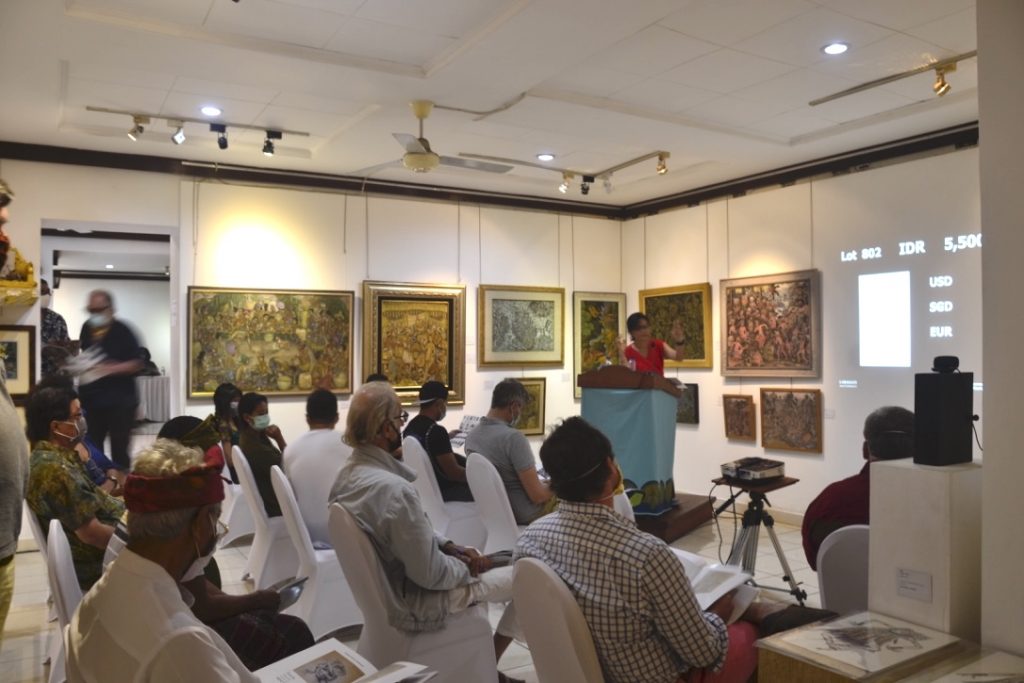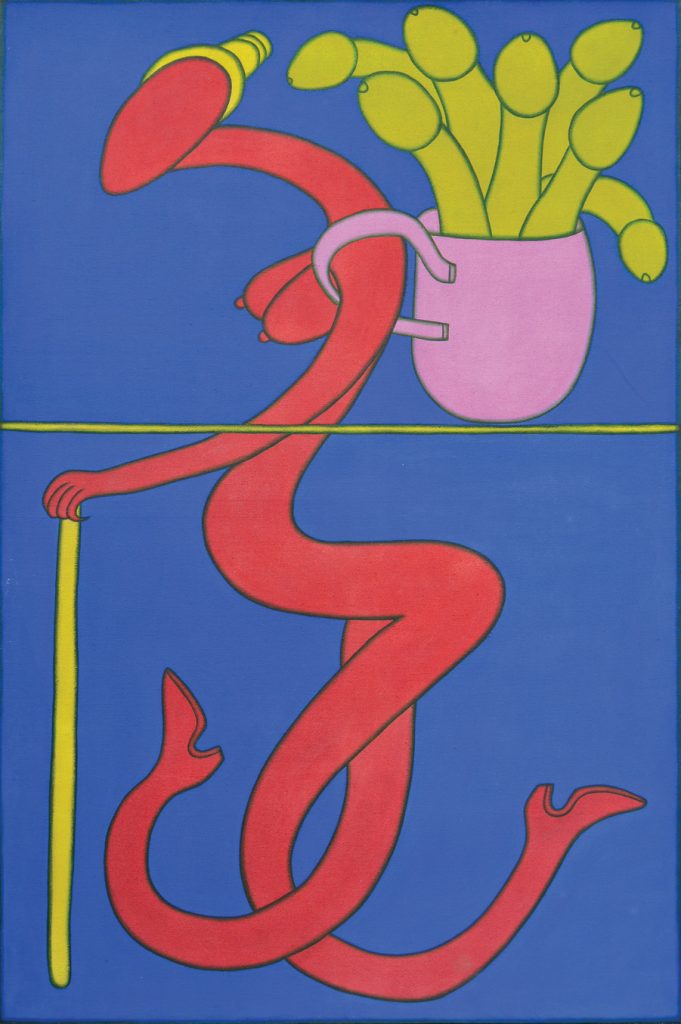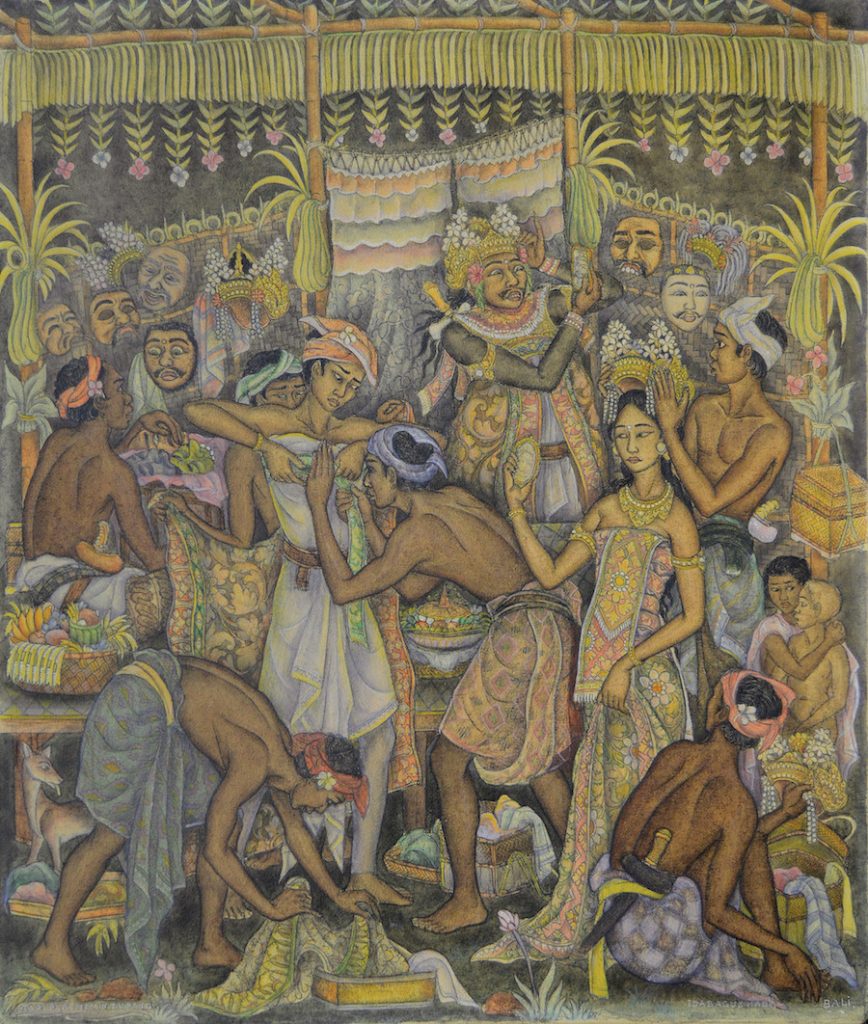The 2020 pandemic has had a disastrous effect upon the Bali economy. Heavily dependent upon tourism, international travel restrictions continue to impact negatively upon the earning capacity of the majority of the island’s population. Especially hard hit are the artists of Bali. The 21st-century creative economy offers growing opportunities for the younger, tech-savvy generations. Artists categorised within the ‘traditional’ sphere, however, are older and generally much slower to adapt to the new digital art world, that has quickly evolved alongside the conventional art world.
A recent auction in Ubud, the birthplace of Bali tourism and the island’s cultural epicentre returned the spotlight to Balinese art made during last century. In the past, exciting new genres created by artists from Ubud and Gianyar Regency captured the hearts and minds of people around the world. In doing so, the artists helped establish the Bali tourism industry beginning over one hundred years ago.

Indonesia’s first international auction house, Larasati, held their ‘Traditional, Modern and Contemporary Art’ Bali sale 5 December 2020 at the Larasati Bali Art Space hosted at Tebesaya Gallery, Ubud. Forty (40) two-dimensional artworks, in a range of styles, by Balinese, Indonesian and international artists went under the hammer.
The escalation of the pandemic last March compelled the public closure of the Indonesian art infrastructure. At the time Larasati were the only Indonesian auction house offering live streaming sales to the market. Conducted live in the saleroom at the Larasati Bali Art Space the sale marked the return of auctions to Ubud after the easing of government restrictions on public gatherings. While the auction was undertaken at considerable risk, it underlined Larasati’s commitment to supporting Balinese art.
From last May Larasati auctions, including sales of Indonesian and Southeast Asian modern and contemporary art, have been held at their Jakarta premises. Closed to the public, yet streamed live online to their growing global audience, the sales were a breakthrough achieving positive results. Supported by the new and convenient Virtual Exhibition facility on their website, prospective buyers and the public can tour preview presentations of each sale.
“Our mission to hold a public auction in Ubud was NOT about making a good sale in terms of dollars and cents. Art in Ubud was, and still is, pretty much a sleeping beauty. From museums to art shops. Ubud herself looks more like an abandoned kingdom,” said Daniel Komala, CEO of Larasati Auctioneers. “What we were essentially trying to achieve was to show the local community that art is still alive. Given the opportunity art could be the first thing to breathe life back into Ubud.”
“Our challenges were plenty, from financial to crowd management. We risked a low attendance and mediocre responses for two new-to-the-market, important works that could have easily been offered and sold well in Jakarta. And we had to apply correct health protocol,” explained Komala.
Responsible Covid protocol garnered public confidence with more than fifty people present spaced out over two levels of the venue. The auction results proved significant, with 90% of the items sold. Lot 830, ‘Jamu Kesukaanku’ by I Gusti Ayu Kadek Murniasih (1966-2006) and Lot 840, ‘Tari Parembon Tupeng’ by Ida Bagus Made Poleng (1915-1999) both set new world record prices in Indonesian Rupiah for Balinese paintings sold at auction. “The Gods of Bali must have blessed us. We passed the test with flying colours,’ Komala stated. “Indeed, the sale achieved 12.5% returns above the total maximum estimate prices.”
The Magic of Murni

The life and art of I Gusti Ayu Kadek Murniasih, ‘Murni’, distinguishes her within a class of her own in the narration of Southeast Asian, and arguably world art. The most important female artist in Indonesian art history, her vibrant minimal figurative/surrealistic works described the plight of women within the patriarchal Balinese society. The village of Pengosekan, Ubud became her adopted home where she developed her imaginative style, while being influenced by the seminal painter Mokoh who was the first Balinese artist invited to the Venice Biennale in 1993.
Murni, who had royal artistic bloodlines from the renowned painter Tjokorda Oka Gambir (1902-1975) of the Peliatan palace, rose from the life as a child of a farmer, poor and uneducated to the ranks of an international icon. Sexually abused by her father at the age of nine her visual language of the subconscious is confrontational, daring, and at times even violent. She broke significant ground into the social taboos of gender politics and feminism. ‘Jamu Kesukaanku’ in striking red, blue and yellow tones is a compelling, yet humorous, sexualised image of a traditional herb seller along with her potent brews. The 150cm by 100cm acrylic on canvas picture had an estimated value of between IDR 75,000,000 – 90,000,000. Enthusiastic bidders for the work, of a size and calibre rarely available to the market, pushed the price upward, eventually selling for IDR 146,400,000 including the 22% buyer’s premium.
Poleng, the Purist

Ida Bagus Made Poleng lived in Tebesaya, Ubud. Born into a high caste Brahmin household, he was considered an art purist raised within a family tradition of making sacred ritual objects and pictures. Poleng’s father, Ida Bagus Kembeng (1897–1952) became a prominent historical figure after winning the prestigious Silver Medal in 1937 at the International Colonial Art Exposition in Paris, France. Poleng’s works are regarded as some of the best examples of the Ubud School of Painting from the early generation of artists, pre-1960s, and have been collected by international (New York MOMA in 1947) and national museums and institutions.
‘Tari Parembon Tupeng’ is a rare work by Poleng in extraordinary condition. The 75.5cm by 64cm tempera on canvas composition has been inspired by the iconic 1954 painting by Poleng’s former teacher, Dutchman Rudolf Bonnet (1895-1978), ‘Bali Dancers Dressing for a Performance’ part of the collection of the art connoisseur and Indonesia’s first President Soekarno. The estimated price was between IDR 420.000.000 – 520.000.000. Spirited bidding pushed the hammer price up to IDR 1,000,400,000 (including buyer’s premium) selling to an anonymous Internet bidder.
Since 2006 Larasati has been dedicated to the development of the market for high quality Balinese art. Their twice annual Ubud sales, and beginning in 2019 three times a year, are a calendar highlight for collectors and connoisseurs. Larasati plays an essential role in a growing market, providing the platform that generates opportunities for buyers and sellers to trade in works in all price ranges. A small, niche market compared to the Indonesian modern and contemporary art market which is the largest in Southeast Asia, art experts believe the Balinese market is undervalued with enormous potential.
The success of the Ubud sale confirms the increasing demand for Balinese art despite the global recession. Unlike Poleng, regarded as the most important Balinese painter of the 20th-century, whose story is documented in ‘Ida Bagus Made: The Art of Devotion’ 2008, Murni’s account has yet to be chronicled. When it does it will dramatically impact upon her international reputation, along with the demand for her work.
www.larasati.com
Instagram: @larasatiauction
Written by Richard Horstman lifeasartasia.art






